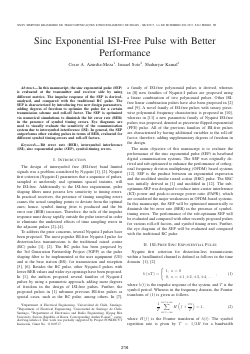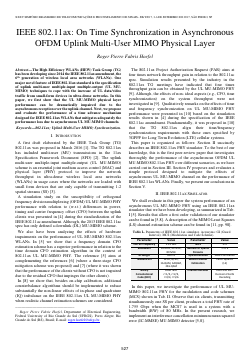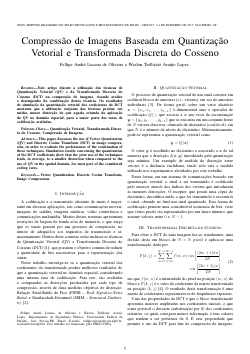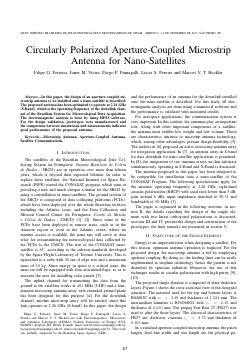
XXXV Simpósio Brasileiro de Telecomunicações e Processamento de Sinais

FPGA implementation of a de-noising using Haar level 5 wavelet transform
Euclides L. Chuma, Luís G. P. Meloni, Yuzo Iano, Leonardo L. Bravo Roger
DOI: 10.14209/sbrt.2017.6
Keywords: Haar wavelet DWT de-noising FPGA.
Abstract
This paper proposes an implementation in Field Programmable Gate Array (FPGA) of a de-noising using Haar wavelet transform. For this a signal with noise was applied at a Haar level 5 Discrete Wavelet Transform (DWT) through an threshold and then through an Inverse Wavelet transfom (IDWT). The design procedure has been designed using the Electronic Design Automation (EDA) tools for system design on FPGA. Simulation, synthesis and implementation on the FPGA target technology has been realized.Download

Sinc Exponential ISI-Free Pulse with Better Performance
Cesar A. Azurdia-Meza, Ismael Soto, Shaharyar Kamal
DOI: 10.14209/sbrt.2017.9
Keywords: Bit error rate (BER) intersymbol interference (ISI) sinc exponential pulse (SEP) symbol-timing errors.
Abstract
In this manuscript, the sinc exponential pulse (SEP) is evaluated at the transmitter and receiver side by using different metrics. The impulse response of the SEP is derived, analysed, and compared with the traditional RC pulse. The SEP is characterized by introducing two new design parameters, adding degrees of freedom to optimize the pulse for a certain transmission scheme and roll-off factor. The SEP is optimized via numerical simulations to diminish the bit error rate (BER) in the presence of symbol timing errors. Eye diagrams are used to visually evaluate the sensitivity of the communication system due to intersymbol interference (ISI). In general, the SEP outperforms other existing pulses in terms of BER, evaluated for different symbol timing-errors and roll-off factors.Download

Análise em Regime Permanente de um Algoritmo NLMS de Passo Variável
Eduardo Vinicius Kuhn, José Gil Fausto Zipf, Rui Seara
DOI: 10.14209/sbrt.2017.8
Keywords: Variable step-size NLMS algorithm adaptive filtering stochastic modeling
Abstract
This paper focuses on the steady-state analysis of a variable step-size normalized least-mean-square (VSS-NLMS) algorithm from the literature, which uses a step-size adjustment rule with high immunity against the measurement noise. Specifically, model expressions are derived aiming to predict the excess mean-square error (EMSE) as well as the mean and mean squared step-size values in steady state. Based on the model expressions, some important characteristics of the algorithm are discussed. Simulation results are presented confirming the accuracy of the obtained model expressions.Download

Desenvolvimento de uma FSS Banda Dupla para Aplicações em Paredes Inteligentes
Alfrêdo Gomes Neto, Jefferson Costa, Silva, Juliete da Silva Souza, Marina de Oliveira Alencar, Thamyris da Silva Evangelista
DOI: 10.14209/sbrt.2017.10
Keywords: FSS intelligent walls WiFi
Abstract
This article presents the implementation of a dual band FSS for intelligent walls applications, covering the WiFi frequency bands, 2.4 GHz and 5.8 GHz. The four arms star geometry, associated to trapezoidal rings, are used, which allows a more flexible frequency response adjust. Initial project equations are introduced and the frequency response characteristics discussed. Numerical and measured results are presented for four FSS, verifying a good agreement, achieving, for the x polarization, a transmission coefficient of, at least, 15 dB of atenuation for each WiFi band.Download

IEEE 802.11ax: On Time Synchronization in Asynchronous OFDM Uplink Multi-User MIMO Physical Layer
Roger Pierre Fabris Hoefel
DOI: 10.14209/sbrt.2017.204
Keywords: 802.11ax,Uplink Multi-User MIMO Synchronization
Abstract
The High Efficiency WLANs (HEW) Task Group (TG) has been developing since 2014 the IEEE 802.11ax amendment, the 6th generation of wireless local area networks (WLANs). One major novel feature of IEEE 802.11ax standard is the specification of uplink multi-user multiple-input multiple-output (UL MUMIMO) techniques to cope with the increase of UL data/video traffic from small-form devices in ultra-dense networks. In this paper, we first show that the UL MU-MIMO physical layer performance can be dramatically impaired due to the asynchronous reception over the uplink channel. Next, we propose and evaluate the performance of a time advance mechanism designed for IEEE 802.11ax WLANs that mitigates adequately the performance loss due to asynchronous UL MU-MIMO channelsDownload

Compressão de Imagens Baseada em Quantização Vetorial e Transformada Discreta do Cosseno
Fellipe André Lucena de Oliveira, Waslon Terllizzie Araújo Lopes
DOI: 10.14209/sbrt.2017.11
Keywords: Vector Quantization Discrete Cosine Transform Image Compression.
Abstract
This paper discusses the use of Vector Quantization (QV) and Discrete Cosine Transform (DCT) in image compression, in order to evaluate the performance of the combination of these techniques. Simulation results concerning the quantization of the DCT coefficients show that the joint use of the techniques leads, in average, to a smaller distortion when compared to the use of QV in the spatial domain, for most part of the considered coding rates.Download

Effects of diversity on the sum rate of a multiuser M-FSK system over fast Rayleigh fading channel
Manish Sharma
DOI: 10.14209/sbrt.2017.13
Keywords: MFSK Multiuser system diversity fading channel.
Abstract
This paper shows how spatial diversity affects multiuser system rate when a multilevel frequency shift keying modulation signal is transmitted over a fast Rayleigh fading channel with additive white Gaussian noise. No specific multiple access method is used. The channel’s short coherence time precludes the system from estimation or tracking channel parameters. Results show that, in this situation, transmitter diversity is ineffective while receiver diversity has a considerable influence on system rate, as well as increasing the optimum number of users that can share the channel at the same time. It is also shown that in this scenario spectral efficiency can be improved by increasing the number of frequency slots, in opposition to the single user Gaussian noise case.Download

Aggregate interference from HAPS into FWA systems: A probabilistic approach
Alberth Tamo, Jose Mauro P. Fortes
DOI: 10.14209/sbrt.2017.205
Keywords: High Altitude Platforms Stations Probabilistic Modeling Fixed Wireless Access Point-to-Multipoint
Abstract
This paper presents a probabilistic model to assess the interference produced by HAPS systems into FWA systems operating in the same frequency bands. To avoid some of the conservative assumptions considered in the traditional interference evaluation methods, in the proposed probabilistic approach the sidelobe antenna gains are characterized by random variables. Minimum operating distances between FWA receivers and HAPS systems are defined and evaluated using the proposed probabilistic model, for some specific interfering scenarios. Results are compared to those obtained with the usual deterministic approach.Download

Nova Abordagem de Redes Neurais de Função de Base Radial de Valores Complexos para Modelagem Comportamental de Amplificadores de Potência
Walter Bastos Pfeffer, Eduardo Gonçalves de Lima
DOI: 10.14209/sbrt.2017.14
Keywords: Modeling neural networks power amplifier radio frequency wireless communication systems
Abstract
This work deals with the behavioral modeling of power amplifiers for wireless communication systems based on complex-valued radial basis function neural network (CVRBFNN). In this work, modifications on the CVRBFNN input and output are proposed with the purpose of optimizing its usage for low-pass equivalent modeling. In comparison with a previous approach of same computational complexity, results from a case study show an improvement in modeling accuracy of up to 8.74 dB in normalized mean square error by the adoption of the proposed configurationDownload

Circularly Polarized Aperture-Coupled Microstrip Antenna for Nano-Satellites
Filipe G. Ferreira, Juner M. Vieira, Diego P. Fumagalli, Lucas S. Pereira, Marcos V. T. Heckler
DOI: 10.14209/sbrt.2017.12
Keywords: Microstrip Antenna Aperture-Coupled Antenna Satellite Communications.
Abstract
In this paper, the design of an aperture-coupled microstrip antenna to be installed onto a nano-satellite is described. The proposed antenna has been optimized to operate at 2.26 GHz (S-Band), which is the operating frequency of the downlink channel of the Brazilian System for Meteorological Data Acquisition. The electromagnetic analysis is done by using HFSS software. For the design validation, prototypes were manufactured and the comparison between simulations and measurements indicates good performance of the proposed antenna.Download